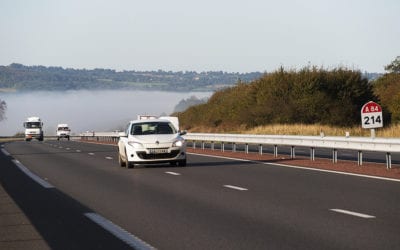I have ten essential tips to prevent extra car rental charges for existing damage and to forestall other problems.

When I picked up my rental vehicle at Los Angeles International Airport, I checked the physical condition of the exterior and interior of the car. Renters need to carefully document nicks, dents, scratches inside and out, and stains and burns in the interior.
I noticed a rusted dent behind the left headlight when I got to the car. The car wasn’t well washed. Regrettably, that was just the beginning. Before loading my luggage in the trunk, I documented the rental car’s condition with photos and video. Too often, rental car companies will charge renters for damages caused during prior rentals, unless you have proof the damage already existed when you began your rental. Photo and video documentation of the vehicle’s condition during the rental is essential to avoid unwarranted damage charges.
Photo and video documentation of existing vehicle damage is essential for all car rentals to prove you didn’t cause the damage when you return your rental.
My documentation uncovered 16 exterior nicks, dents and scratches. Inside, there was mud on the back of the driver’s side front seat. I also noticed holes in the bottom of the cup holders, door handle areas and cell phone plug-in area, etc, indicating missing parts. There was a cigarette scorch mark on the back seat.
At that point, the decision was made for me.
Due to the sheer number of exterior and interior issues, the poor cleaning likely hiding additional damage and the missing pieces, I refused to take the car. I quickly showed the rental agent how bad the condition of the car was and told her to get me another. I had it within five minutes.
If the damages are too numerous, you’re taking a big chance about whether or not the car rental company will charge you to repair and repaint the vehicle, even with your photos and videos. No one needs the hassle and arguments that will ensue and there’s no guarantee that you will prevail over the rental car company. The repair cost is potentially just the start of the damage charges. You’ll be charged for the time the car is being repaired because during that time, the car rental company can’t rent the car to anyone else. That charge can quickly mount and easily surpass the charge for repairing the car.
If your rental car’s preexisting damage is excessive, photo and video documentation may not be enough to ensure you’re not charged for damage you didn’t cause.
If your rental car shows any damage, inside or out:
Start at the driver’s side headlight and move around the car photographing any damage from nicks, dents and scratches, plus any missing pieces including rubber molding. Then make a video of the car doing the same and explaining what you’re seeing as you make the video. Repeat this for the interior.
If your rental car has more than 10 or so physical problems:
With that much damage, avoid the vehicle. When a car is missing parts, don’t take it.
If your rental car wasn’t washed well:
If the vehicle is poorly cleaned there could be hidden damage underneath the dirt. Leave the car on the rental car lot.
Here are my other top tips to prevent rental car problems while traveling.
Be sure your rental car is fully functional before leaving the rental car lot.
Check your car mechanically before leaving the lot:
Ensure that you have a full or “donut” spare tire and jack and tire iron with the right locking nut removal tool before you leave the rental company lot. Check your tires’ treads to be sure that they’re sufficient, especially in winter.
Check your car’s air conditioning, heating, lights, windshield wipers, mirrors, controls, etc. to ensure you know how to work them and that they are working properly before accepting the car at the rental company.
If you’ve had to swap rental cars due to an accident or repair, get a rental car employee’s signature that acknowledges receipt of the car to prevent problems of the rental being declared missing or stolen.
Document rental car swaps or car returns for extended rentals:
Recently at Hertz and no doubt occasionally at other car rental companies, rental cars are being reported stolen and renters arrested because of rental company documentation failures. With their paperwork incomplete, missing or in error, they report the car as missing or stolen.
This happens mostly when you get a swapped out vehicle due to car problems or an accident or return a car after extending your rental period. If that happens to you, never leave the return car lot until you get a company employee to sign your contract showing that they’ve taken possession of the car.
I’ve been in two accidents with rental cars over the years and have gotten a swapped car each time. One of those times the rental company said I didn’t return their vehicle. I emailed the signed contract where their employee acknowledged receipt of the car. Fortunately, that was the end of the problem.
Prevent problems from license plate photo-based tolls, international car rental rules and pairing your smartphone with the rental car.
Tolls:
Beware that rental car companies often charge hefty fees on top of the tolls to pay your road/bridge tolls when they are by license plate photos. They also charge a significant usage fee for their toll transceivers. When traveling in the area of the U.S. that uses EZ-Pass, I bring my transceiver from home.
Know the rental car rules for the country of rental:
Some countries have special rules and mandatory fees for rental cars. Your car insurance from home might not be valid in some countries. Be sure you know the rules.
Consider not pairing your smartphone with the car:
Most renters aren’t prepared to delete their data from their rental car when dropping it off. Unless you’re prepared to do so, don’t pair with the car unless you want the company and future renters to be able to see your contacts and personal information.
Know what fuel your rental car uses and fill the tank before returning the car.
Know what fuel your rental uses:
This is mostly a problem outside the U.S., where many cars use diesel fuel. If you put the wrong fuel in the car, you are liable and insurance won’t cover the mistake. Repairs for this are generally very costly, typically more than $2,500 U.S.
If your rental is an electric vehicle, know what kind of charging stations you can use, how to open the charge connector area, how to plug in the charger and if you need any adapter for some charging stations. Make sure you have the proper adaptor. If you’re renting an electric vehicle, you’ll likely need at least one vehicle charging account in order to use charging stations on the road.
Don’t forget to fill your fuel tank:
You can pay to be able to return your rental car without refilling the tank to full. However, that charge is often two or three times the actual cost of the fuel. I located a filling station near the car rental return and allowed enough time to refill the tank there. The penalty for not filling the tank is significant.
By following these tips, you’re not guaranteed to eliminate charges for damage you didn’t incur or prevent all problems with your rental car while using it, but they will help you prevent many of them.
READ ALSO:
How to dress up on your next flight for comfort, health and safety
Join Travelers United — Membership includes a top cybersecurity package with a Swiss global data vault
After many years working in corporate America as a chemical engineer, executive and eventually CFO of a multinational manufacturer, Ned founded a tech consulting company and later restarted NSL Photography, his photography business. Before entering the corporate world, Ned worked as a Public Health Engineer for the Philadelphia Department of Public Health. As a well known corporate, travel and wildlife photographer, Ned travels the world writing about travel and photography, as well as running photography workshops, seminars and photowalks. Visit Ned’s Photography Blog and Galleries.


